VITA Zahnfabrik
H. Rauter GmbH & Co. KG
Spitalgasse 3
79713 Bad Säckingen

Clinical success rates for CAD/CAM crowns made of VITABLOCS feldspar ceramic
The world's first dental CAD/CAM material VITABLOCS Mark II (VITA Zahnfabrik, Bad Säckingen, Germany) was launched over 30 years ago, and has since proven itself a million times over. Using the blanks made of fine-structure feldspar ceramic, singletooth restorations can be produced with the time-saving advantages of CAD/CAM. For over 17 years, PD Dr. Andreas Bindl observed and documented the long-term clinical success of this material. In the following interview, he explains his methodology, describes the results obtained and shares his many years of clinical experience with VITABLOCS Mark II.
DV: How did you proceed with your research and what data was collected during the clinical study?
PD Dr. Andreas Bindl: We designed the prospective study in the 1990s. The parameters we wanted to monitor and the data to be collected for this purpose were precisely defined in advance. It is not enough to simply look at the crown. This has to be carried out according to a standardized study protocol. To achieve this, we based our work on the current USPHS criteria, but with adjustments for examining the crowns. The assessment criteria included, for example, whether there was a fracture, whether the crown was still in place, the condition of the luting joint and the shade or the surface quality. The final publication that includes the data obtained from this study is currently being prepared.
DV: What clinical survival rates do VITABLOCS molar crowns achieve after an observation period of 17 years?
PD Dr. Andreas Bindl: We have made a distinction here between three different types of crown preparations. For the classic full crown preparation with normal stump height, VITABLOCS Mark II achieved a survival rate of 92%. For the reduced crown preparation without retentive stump preparation, we determined a similar value of 92.3%. Teeth that had been more severely damaged after a root c anal treatment with endocrowns, still showed a very positive survival rate of 87.5% after 17 years. With this restoration, the pulp chamber is used as a retention surface for the adhesively fixed crown.
DV: What factors lead to the slightly lower, long- term durability of endocrowns?
PD Dr. Andreas Bindl: Teeth that are restored using endocrowns undergo – as previously mentioned – a higher degree of damage and for that reason, they also sometimes provide a smaller adhesive surface for adhesive bonding. This loss of retention plays a role in defects with the smaller premolars in particular. Furthermore, the adhesive bond in this type of restoration takes place mainly in the dentin, which is less favorable when it comes to adhesive values.
DV: What was the wear or abrasion resistance of the feldspar ceramic during the follow-up examinations?
PD Dr. Andreas Bindl: Exact clinical measurements are impossible, of course. It is a fact, however, that over the course of the long-term clinical process, abrasive surfaces appear on the crowns as they do on natural tooth structures. This is a good indicator and prevents non-physiological damage of the dental antagonist. The enamel-like abrasion of the VITABLOCS Mark II ceramic is much more evident in inlay restorations. Here you can clearly see that enamel and feldspar ceramic undergo uniform wear.
DV: In your experience, how well do VITABLOCS reconstructions integrate into the natural dentition, in terms of their play of color and light?
PD Dr. Andreas Bindl: The remaining tooth structure plays a crucial role here. If it shows strong discoloration, one can expect that this discoloration will show through and affect the esthetic appearance of the restoration. In general, however, VITABLOCS Mark II has a pronounced chameleon effect; in other words, it can visually adapt to the appearance of the natural tooth structure. This results in a natural play of color and light, which is why I also like to use feldspar ceramic in the esthetically visible area. VITABLOCS ceramic is one of the most esthetic materials on the dental market because it is so similar in appearance to the natural tooth structure. Instead of polishing, the surface can also be characterized using stains and glazes.
DV: What should dentists consider when pro cessing and using VITABLOCS in clinical environments to achieve excellent long-term clinical stability?
PD Dr. Andreas Bindl: On the one hand, clean, full-adhesive bonding with composite cement material is essential for a long-term stable restoration with feldspar ceramic. On the other hand, compliance with the minimum wall thickness, especially in the occlusal area, is essential to avoid fractures.
Report 04/20
Dentist PD Dr. Andreas Bindl
Zurich, Switzerland
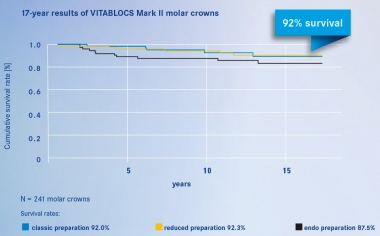
Graphic 1 Survival rates for molar crowns made of VITABLOCS Mark II feldspar ceramic after an observation period of 17 years.
Source: External study 2016, University of Zurich/practice am Zürichberg, Survival rate of CAD/CAM crowns in the posterior tooth region on different preparation geometries without consideration of biological failures (PD Dr. Andreas Bindl)
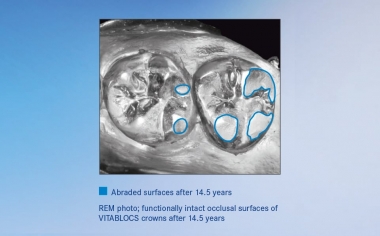
Graphic 2 Studies showed that restorations made of VITABLOCS exhibit abrasion behavior similar to nature.
Source External study 2016, University of Zurich/ practice am Zürichberg, Epoxy model of impression after 14.5 years, vapor-plated with gold, b/w photo of the model (PD Dr. Andreas Bindl)
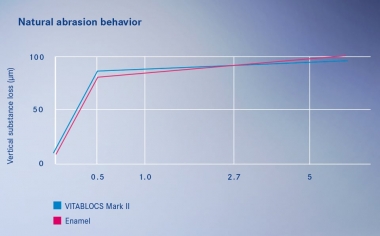
Graphic 2 Studies showed that restorations made of VITABLOCS exhibit abrasion behavior similar to nature.
Source External study 1991, Wear of Cerec and other Restorative Materials. In Proceedings of the International Symposium on Computer Restorations: State of the Art of the Cerec Method, (Krejci, Berlin: Quintessence Publishing, 245 – 251
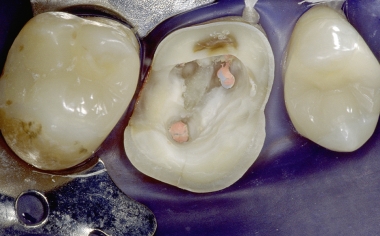
Fig. 1a Endocrown preparation with reduced retention and primarily adhesive bond in less favorable dentin.
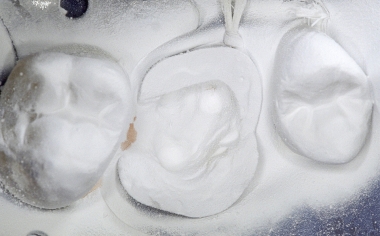
Fig. 1b For the intraoral scan, the endocrown preparation and adjacent teeth were powdered.
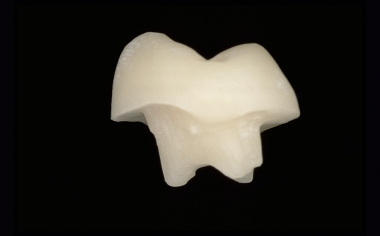
Fig. 1c The CAD/CAM-supported finished endocrown after finishing and polishing.
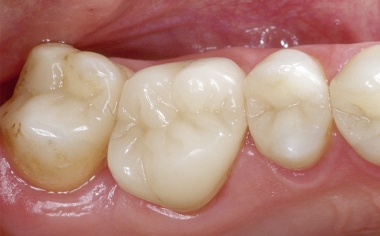
Fig. 1d The clinical baseline situation directly after the full-adhesive cementation.
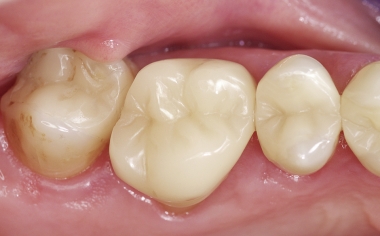
Fig. 1e Condition of the endocrown restoration 17 years after the seating.
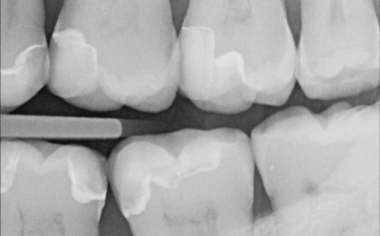
Fig. 2a Intact inlay (OM) on tooth 17 after 14 years.
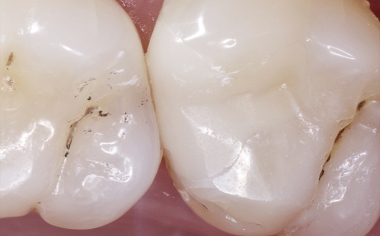
Fig. 2b Harmonious wear between feldspar ceramic and enamel after 14 years.